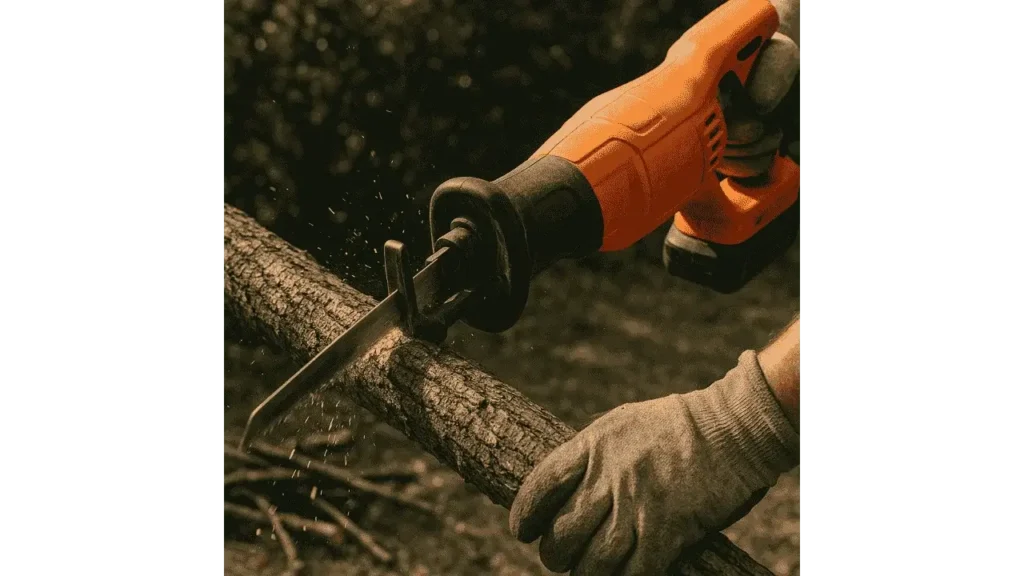A reciprocating saw is a handheld power tool that cuts with a back‑and‑forth blade motion. It’s valued for versatility more than precision. From my own experience on job sites, it’s the first tool we grab when speed and reach matter more than clean lines. Knowing its core uses helps you choose the right blade for each task and get better results without unnecessary effort.
Core Applications of a Reciprocating Saw
“A recip saw is like a universal key for tough jobs, it saves time where other saws can’t even start,” says contractor Mike Reynolds.
Demolition & Renovation
This saw is ideal for tearing down walls, removing old framing, and cutting through mixed materials like wood with nails, drywall, or light metal. Its aggressive motion makes it the tool of choice when speed is more important than a polished edge.
Plumbing, Electrical & Mechanical Work
Plumbers and electricians often use it for cutting pipes, conduit, or making quick access cuts in framing. Compact versions are especially useful in cramped spaces.
Metal Cutting Tasks
With a proper bi‑metal or carbide blade, a reciprocating saw can slice through sheet metal, bolts, rebar, or steel tubing.
“Turn off orbital mode when cutting metal, straight strokes mean cooler blades and smoother results,” notes tool technician Sarah Lopez.
Outdoor Pruning & Landscaping
Fitted with a coarse blade, it works well for trimming branches, shrubs, or small trees. It offers more speed and less effort than manual saws, making it handy for garden upkeep.
Other Specialized Uses
The slim body and long blade make it useful in tight or awkward spaces, behind walls, between studs, or near flooring. With scraper blades, it can also remove adhesives or grout.
Materials You Can Cut with a Reciprocating Saw
“Blade choice makes all the difference, match teeth per inch to the material and you’ll cut faster and safer,” explains renovation expert David Carter.
Wood & Lumber (with/without nails)
A reciprocating saw easily handles framing lumber, beams, and joists, even when nails are embedded. From experience on renovation jobs, it’s the fastest way to open up framing without worrying about hidden fasteners slowing progress.
Metal & Pipes
With the right blade, it cuts thin sheet, conduit, or even heavy pipe. The key is using a steady hand and letting the blade do the work, something I’ve found makes tough plumbing cuts much safer and cleaner.
Plastic, PVC & Composites
PVC plumbing and composite boards are common materials this saw handles well. Choosing a fine‑tooth blade prevents melting, and supporting the material stops chatter, lessons I’ve applied countless times on quick repair jobs.
Drywall, Plaster, Mixed Materials
During remodeling, it proves perfect for cutting drywall, plaster, or mixed assemblies. It saves time by handling different layers at once, a real advantage when working through walls with a combination of wood and finish materials.
When Is a Reciprocating Saw Not Ideal?
It’s not meant for finish work or fine woodworking. Very thin materials may tear, and projects needing perfect edges are better suited to jigsaws, circular saws, or miter saws.
Tips & Best Practices for Using a Reciprocating Saw in These Uses
Choose the correct blade (coarse for wood, fine for metal, carbide for tougher materials). Keep orbital mode off for metal. Brace the shoe against the work to control vibration, and secure materials to prevent kickback. Start slowly, let the saw do the work, and always wear protective gear.
“Most mistakes happen when users push too hard, patience makes the blade last longer and keeps cuts cleaner,” says safety trainer Karen Miller.
FAQs
What is a reciprocating saw used for in demolition?
A reciprocating saw is used in demolition to cut through walls, timber, drywall, nails, and mixed materials quickly and efficiently.
Can a reciprocating saw be used for plumbing or electrical jobs?
Yes , a reciprocating saw is often used for plumbing and electrical tasks like cutting pipes, conduit, or making access cuts in framing.
What materials can a reciprocating saw cut?
A reciprocating saw can cut through wood, metal, PVC, drywall, plaster, and mixed assemblies when fitted with the correct blade.
Is a reciprocating saw useful for outdoor or landscaping tasks?
Absolutely. A reciprocating saw is handy for pruning branches, cutting shrubs, and other yard jobs that require power and reach.
When should you avoid using a reciprocating saw?
You should avoid using a reciprocating saw for fine woodworking or precision cutting; it’s better used where rough cuts and reach matters more than finish.
Final Takeaways
A reciprocating saw is a practical, multi‑purpose tool for demolition, plumbing, metal cutting, pruning, and hard‑to‑reach jobs. Its true strength lies in speed and adaptability, not precision. Match the blade and settings to the material, and this saw becomes one of the most valuable tools in your kit.
- How to Cut a Straight Line with a Jigsaw? - October 31, 2025
- How to Cut a Circle with a Jigsaw? - October 31, 2025
- Can You Cut Acrylic with a Jigsaw? - October 31, 2025

